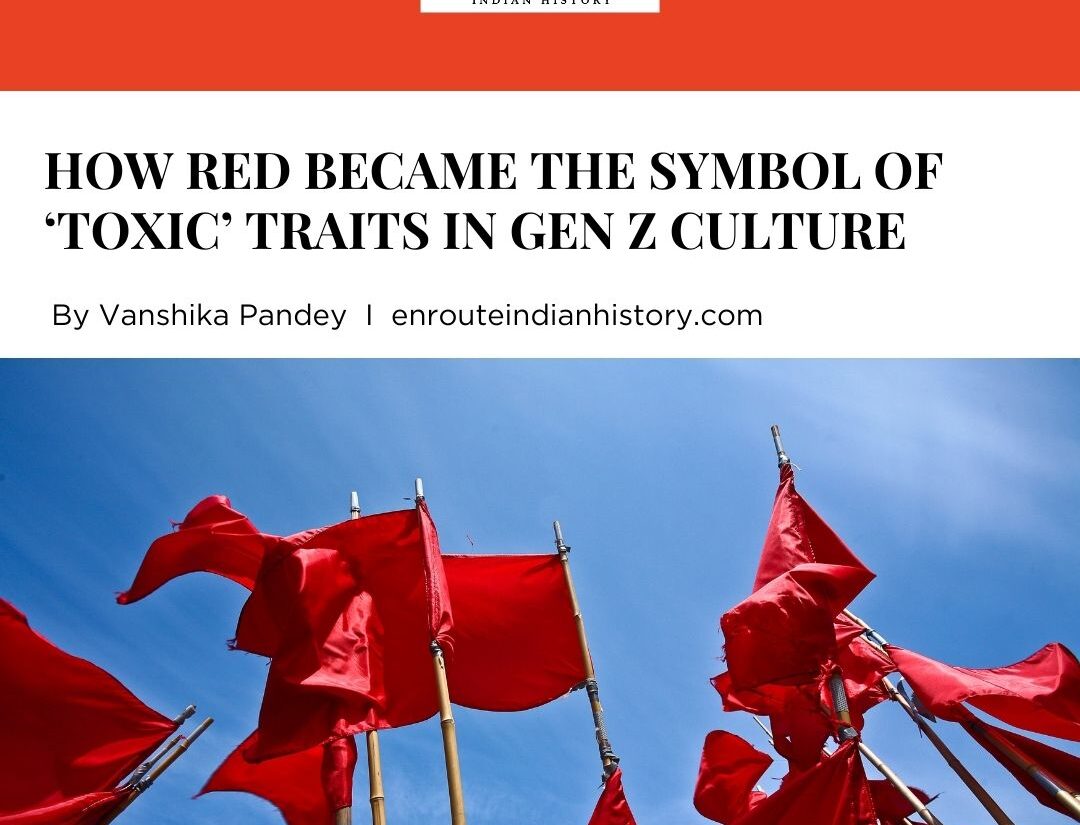Unveiling Gen Zs Embrace of the Term "Red Flag" and the Culture of Colour Symbolism
- EIH User
- July 3, 2024

Unveiling Gen Zs Embrace of the Term “Red Flag” and the Culture of Colour Symbolism

In the vibrant, emoji-filled landscape of social media, one phrase has soared to meme stardom: “red flag”(Symbolism). No, we’re not talking about literal flags waving in the air at sporting events or pirate ships. We’re diving into the world of digital lingo where a red flag is a metaphorical warning sign, the modern-day smoke signal that screams, “Stay away!” It’s the virtual equivalent of a friend’s disapproving glare when you tell them you’re considering texting your ex. But how did this term become the catchy, viral sensation it is today? Buckle up, because we’re about to journey through history, social media trends, and a splash of colour psychology to uncover the roots and rise of this now-iconic phrase.
The history of Red Flags from the Battlefields to Breakups is quite interesting, to understand the modern use of “red flag,” we first need to travel back in time to ancient battlefields. Historically, red flags were used as signals of danger or warning. In military contexts, they often indicated that a position would be defended to the death, or that a battle was imminent. Fast forward a few centuries and red flags started popping up in all sorts of contexts—particularly in maritime settings, where they were used to signal bad weather or quarantine situations. Imagine sailing into a port and seeing a red flag; it was like the 18th-century version of receiving a “Hey, don’t come any closer!” text.
In the 20th century, the term “red flag” began to evolve, becoming a metaphor for warning signs in various areas of life, from politics to personal relationships. The 1980s saw psychologists adopting the term to describe warning signs in relationships and behaviours, and by the early 2000s, it had cemented its place in self-help books and therapy sessions. Yet, it wasn’t until the digital age that the term would explode into the pop culture lexicon.
Enter Gen Z, the first true digital natives, whose lives are as intertwined with technology as bees are with honey. For Gen Z, social media isn’t just a tool; it’s a lifestyle. Platforms like Twitter, Instagram, and TikTok are their playgrounds, news sources, and stages for self-expression. Within these virtual realms, trends and slang spread faster than a cute dog video.
The red flag metaphor found fertile ground in this environment. In late 2020 and early 2021, “red flag” memes began cropping up everywhere. These memes typically feature a list of statements or behaviours that would be considered warning signs, accompanied by a parade of red flag emojis. For instance, “He uses the term Alpha to describe himself ???” or “She does not like dogs ???.” The humour lies in the exaggeration and relatability—everyone has encountered those quirky deal-breakers.
TikTok, in particular, played a significant role in catapulting the red flag trend into the mainstream. Short, snappy videos that highlight red flags in dating, friendships, and everyday interactions became wildly popular. Influencers and everyday users alike jumped on the bandwagon, creating content that ranged from the hilarious to the downright absurd. It’s like a global, digital scavenger hunt where everyone’s looking for those pesky red flags.
So, why did the colour red get the dubious honour of symbolising danger and warning? It all boils down to colour psychology and cultural associations. Red is a colour that grabs attention—it’s the colour of fire trucks, stop signs and emergency exits. Psychologically, red is linked to strong emotions like love, passion, and anger. It’s a colour that can trigger an adrenaline response, making us more alert and aware of potential dangers.
Historically, various cultures have used red symbolism to signify everything from luck and prosperity to war and revolution. In the context of warnings, its association with blood and fire likely plays a significant role. Our ancestors learned to associate red with danger and urgency, a notion that has trickled down through generations.
In the world of social media, colours play a crucial role in communication. Emojis, those tiny pictorial marvels, leverage colour to convey meaning instantly. A red flag emoji isn’t just a tiny picture; it’s a powerful symbol loaded with cultural and psychological connotations. It tells a whole story in one small image, making it the perfect tool for social media’s fast-paced, visual-centric world.
The rise of the red flag meme is a testament to the broader culture of colour symbolism that permeates our digital lives. Colours are a universal language, one that transcends words and can communicate complex ideas with stunning simplicity. Consider the green light emoji, often used to signal approval or “go ahead,” or the blue heart, which can signify platonic love or sadness. Each colour carries a unique set of meanings and emotional weights, allowing for nuanced communication in the quick-swipe era.
Gen Z, in particular, has embraced this visual shorthand. Growing up in a world saturated with images and emojis, they’ve become adept at using colour to convey messages. This skill extends beyond social media into marketing, fashion, and even mental health advocacy. For example, the color pink has been rebranded from a symbol of girlishness to one of empowerment and rebellion, thanks in part to movements like Breast Cancer Awareness and the global Women’s March.
In a way, the red flag phenomenon is a microcosm of how Gen Z uses colour symbolism to navigate their world. It’s a blend of humour, social commentary, and a touch of sarcasm, wrapped up in a bright, eye-catching package. This generation has a knack for taking something simple—like a colour —and transforming it into a potent symbol of shared experiences and values.
In the end, the meteoric rise of the “red flag” term among Gen Z on social media is a fascinating example of how language evolves and adapts in the digital age. What started as a literal signal of danger on battlefields and ships has transformed into a humorous, relatable, and highly visual way of identifying and sharing personal deal-breakers.
The red flag trend underscores the power of colour symbolism in our lives, especially in the fast-paced, image-driven world of social media. It’s a testament to the creativity and ingenuity of Gen Z, who have taken a centuries-old concept and given it new life in the form of memes and emojis. So next time you see a red flag (literal or metaphorical), remember: it’s more than just a warning—it’s a piece of cultural history, a psychological trigger, and, most importantly, a hilarious way to navigate the sometimes choppy waters of modern relationships.
Now, if you’ll excuse me, I need to go check if my latest crush has any red flags. ???

















